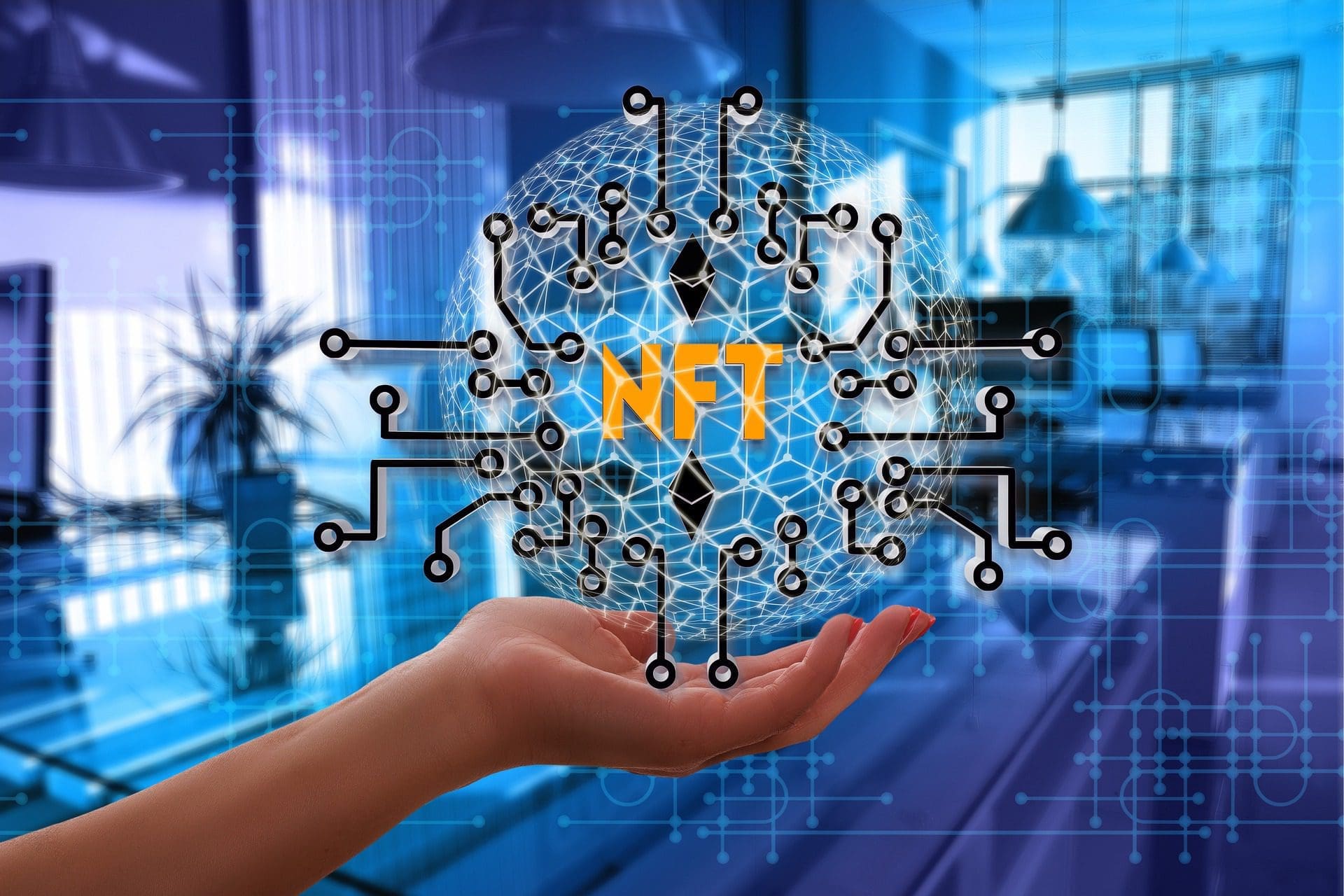Though NFTs have technically been around since 2017, they only recently started gaining popularity in early 2021 when an artist named Beeple sold an NFT of his work for $69 million. Though most NFTs do not typically sell for that much, the average weekly totals for all NFT sales can range anywhere from $15,000 to $50,000.
Guest post by Katie Brenneman. Image by Gerd Altmann
With such potential, NFTs have now created quite the buzz, with people everywhere rushing to create and buy NFTs to earn more money and even for investment purposes. However, though many artists are touting the NFT market as a great way to turn a profit, if you don’t fully understand how it all works, you might not succeed.
Not everyone is guaranteed to hit it big when they create and sell an NFT. As with cryptocurrency, the NFT market can be volatile as it is always fluctuating. So if you want to see a return on your investment, you really need to understand how the market works and how to properly create an NFT.
This article will take a closer look at what NFTs are, the benefits of creating NFTs, and how to create, market, and sell your NFTs for fun and profit.
What Are NFTs?
In the simplest of definitions, an NFT is like a digital certificate or a “token” of a digital file that guarantees one person as the owner of that file and that there are no other files like it. In other words, that file has no equal, and it is, thus, considered non-fungible.
In the digital world, an NFT is like a sort of currency — like cryptocurrency — only each NFT cannot be replicated. NFTs are one of a kind, making them unique or special and worth money. For example, one dollar bill is the same as another dollar bill, or one Bitcoin is equal to another Bitcoin — these things can be used interchangeably with assets of the same value. In contrast, one NFT cannot be exchanged for another NFT.
As for what an NFT can be, that is less set in stone. An NFT can be just about anything that can be turned into a digital file. It can be a video clip, a music file, or a drawing. You can even sell your photographs or poetry and books as NFTs. With digital art becoming more popular these days, NFTs tend to be digital art files.
Once a digital file is created, it can then be turned into an NFT, called being “minted”, and sold on blockchain. Blockchain is the same technology used to buy, sell, and trade cryptocurrencies. When someone then purchases an NFT, they are essentially buying ownership rights to that digital file, proving that they are the owner and that there are no other owners or copies of that NFT. And blockchain is what secures and keeps track of who owns or is selling that NFT.
As such, there are essentially five elements that make up an NFT:
- A unique ID that encapsulates all of the asset’s characteristics;
- Proof of ownership;
- The rights and privileges of that ownership;
- Digital encryption;
- Blockchain registration.
What Are the Advantages of Creating NFTs?
There are reasons why someone would create and sell an NFT versus simply making a work of art and selling it traditionally. The three primary advantages to making NFT art versus making traditional art or other types of digital art include:
Ownership: Again, NFTs are unique, and there can be no other file like them as they are encrypted, tracked, and assigned a certificate of ownership. This makes owning an NFT potentially more valuable than owning a physical work of art because you can guarantee that there are no copies and you are the sole owner. This is also why some artists can sell their NFTs for so much. They are essentially like rare, one-of-a-kind items.
- Security: Blockchain is a highly secure, encrypted platform. Since NFTs can only exist on blockchain platforms, it makes them very well-protected. They cannot easily be stolen, copied, or forged. NFTs also exist on a decentralized network that is not controlled by any central authority, making them even more secure.
- Portability: Unlike physical works of art, NFTs can very easily and quickly be taken with you wherever you go as they simply exist in the digital world. They can also be more easily transferred between one owner or user to another as this doesn’t require a face-to-face transaction.
How To Create Your Own NFTs
Now that you understand the basics of NFTs and how NFT markets work, it’s time to start making your own NFTs.
Create Your Content
To start, you’ll want to decide what kind of art or content you want to create and sell. An NFT can be anything that can be turned into a multimedia file. This includes digital paintings, drawings, graphics, photographs, text, video, or audio files. It can also include digital representations of things that can exist in the metaverse, such as virtual avatars or land.
When creating your content, it’s also a good idea to protect the digital file on your computer using secure programs. Even though the file will be secured on blockchain once it is minted, you still want to make sure no one can hack your computer and steal your art before it is uploaded to an NFT marketplace. Use password-protected files that are unable to be edited to decrease the chances of this happening.
“Mint” Your NFT
After you have created your digital file, you will then turn it into an official NFT by “minting” it or turning it into a non-fungible token with blockchain technology. To do this, you will need to decide which blockchain you want to work with. The most popular blockchain platform is Ethereum, but there are many options, including Binance, SmartChain, and Tezos.
Set Up a Crypto Wallet
Since NFTs exist on cryptocurrency blockchain platforms, you will need a digital cryptocurrency wallet to get your NFT set up in a marketplace and to collect the currency from the sale. As with blockchains, there are also a wide variety of digital wallets to choose from, such as Coinbase Wallet or Trust Wallet. Just use caution and vet any crypto wallet for security practices before storing any personal information or funds.
Choose Your NFT Marketplace
The second part of minting your NFT after getting it on a blockchain platform is to set it up in a marketplace. There are a number of NFT marketplaces to choose from, and you will want to be mindful of the one you select as no two are the same.
For example, NBA Top Shop is for basketball items, and Axie is specifically for NFTs created for the game “Axie Infinity.” You want to choose a marketplace that is geared toward the kind of NFT content you are creating.
If you aren’t sure which marketplace to choose, you can start with OpenSea. OpenSea is the largest NFT marketplace that caters to a wide variety of NFTs and tends to garner the most sales. After you choose your marketplace, you will then upload your NFT file and connect your account to your digital wallet. Then, you can pay any fees for getting set up and collect currency for the sale of your NFTs.
Set Up Your NFT for Sale
Once your NFT is uploaded and minted on a marketplace, you will need to decide the price and how you want to sell it. Different marketplaces offer different options. For example, some allow you to sell at a fixed price, and others allow you to set your NFT up for auction.
Market Your NFT
If you are a lesser-known artist, it’s a good idea to promote and market your NFT to try and boost sales. The more hype you raise for your work, the more money you are likely to get. You can promote online using online advertising and social media, or you can even promote your NFT using traditional marketing by running print ads. Ultimately, you should promote your NFT wherever you think it will garner the most attention and cater to your audience.
Though the process of creating and setting up an NFT might not seem that hard, there is no guarantee that your NFT will sell for a high dollar amount, especially your first time around. But the more you keep at it and the more you market and promote your NFTs, the more likely you are to start turning a profit.
Of course, creating NFTs doesn’t just have to be a financial pursuit. For many artists, creating is simply about the joy and fun of the process and how it improves their happiness. After all, artistic hobbies can improve mental health — and digital hobbies have that same potential. Creating art in any format should bring you some level of joy, even if you are, eventually, doing it for money.


